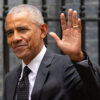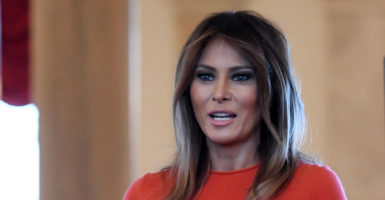When the Trumps visited Paris last June to celebrate Bastille Day at the invitation of President Emmanuel Macron, they were honored in quintessentially French grandeur.
From the dinner with an amazing view atop the Eiffel Tower to the military parade replete with French soldiers atop mounted steeds marching down the Champs Elysees, the American president and first lady were received in impressive style, which obviously made a strong and positive impression.
The Trumps and Macrons have a clear affinity for one another, which certainly helps smooth the path of diplomacy with our nation’s oldest ally.
This week, President Donald Trump and first lady Melania Trump are reciprocating the hospitality of the French president and his wife by hosting them on their historic first state visit to the Washington.
Already, there are signs of the typical diplomatic protocol and meticulous attention to detail—and there have been a few surprising moments. For example, when the first lady and Brigitte Macron joined their husbands on the podium at Tuesday’s arrival ceremony (rather than being escorted off to be seated on sidelines as in previous years), they sent a powerful message of partnership and support, standing front and center on stage with their husbands attired in striking, complementary white suits.
Looking ahead to the state dinner, which is always the highlight of an official visit, watch for additional clues that blend style and substance, hospitality and diplomacy.
Melania Trump has reportedly been working on the details of the state dinner for months, which were revealed in Monday’s candlelight press preview and in a short video released earlier in the day. The presentation of décor was notable for a few reasons: Her hands-on approach and attention to detail signify an intuitive understanding of the power and symbolism of White House entertaining in the context of international diplomacy.
Moreover, the fact that the first lady eschewed hiring an outside event planner for the occasion not only signifies personal confidence in her ability to coordinate style and décor, but supports administration policies of reducing the burden of official entertaining on American taxpayers. An in-house event, executed by her small East Wing staff, will substantially reduce the costs of the dinner, making a powerful point.
There are additional signs that signal the first lady’s interest in both creating a welcoming ambiance for her guests and sending a larger message of inclusion and thoughtfulness, evidenced by special personal touches and a simple change in scheduling of the press preview.
In the past, press previews were often hastily arranged—they were somewhat awkward affairs squeezed in around the arrival ceremony and press conference and before the main event. The mock-up tables in the State Dining Room sometimes clashed with the existing White House décor, since the dinners typically took place in an outside tent.
By holding the press preview in the State Dining Room the evening before the actual state dinner, with the full room on display exactly as it will look tonight, the first lady is inviting all of us to see the backdrop for this first official state visit of the Trump administration—a nice touch for the White House.
In addition, the simple scheduling change—a nod to efficiency and common sense—also reduces the burden on her staff who are focused on executing the state arrival ceremony and the dinner.
In her state dinner décor choices, the first lady is paying homage to White House protocol and history, honoring previous first ladies with her choices of presidential china (the Clinton and Bush china) and showcasing the beautiful collection of White House vermeil pieces, including the gilded basket centerpieces favored by former first lady Jacqueline Kennedy.
Her color scheme of white, cream, and gold was favored by several other first ladies, including Nancy Reagan and Laura Bush, and is designed to complement the décor scheme in the State Dining Room.
When the guests enter the State Dining Room, they will be greeted with the fragrance of 2,500 stems of white lilac and 1,500 stems of white sweet peas, and a room lit by natural candlelight, casting an incandescent glow. The integrated décor is designed to highlight the historic architecture and furnishings as well as the imposing portrait of President Abraham Lincoln—the focal point of the room.
The White House is an iconic symbol of American strength, unity, and possibility, and serves as a powerful backdrop for official events such as state dinners. Policies and programs take time to implement, but skillfully crafted and thoughtfully executed events and strategic use of White House symbolism resonate with all Americans, allowing presidents—and first ladies—to connect and communicate directly with the American people.
The state dinner with France is just such an occasion.


























